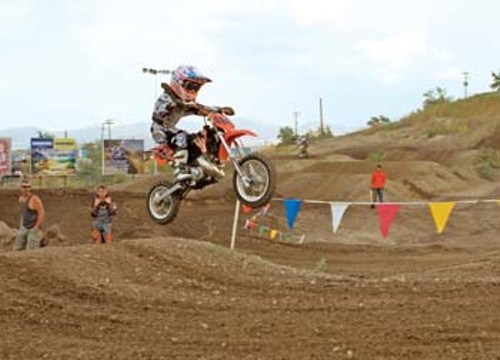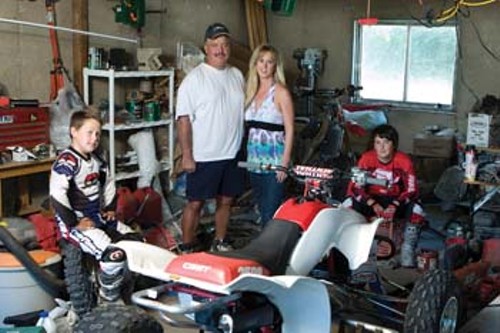Motocross as Child's Play
Young riders increasingly participate in the life-and-death jumps and crashes of the sport.
By Wren AbbottPage 3 of 3
Making the Grade
To practice reading
terrain—finding the fastest lines in the contours of the land—Austin
and Jake go riding out in the west desert. During a race, wheeldeep
ruts form in the track’s fastest lines, and skilled riders are almost
horizontal as they make sharp turns, their tires gripping the walls of
the ruts. Riders learn to “scrub,” or turn the bike sideways when
they’re in the air over jumps—a technique to keep the bike low, to land
quicker in the interest of speed.
As riders get competitive,
they’ll attempt to “high side” the competition, or push them up into
the edge of a track during a race. Watching the pro riders compete on
the RMR course on their imposing 250F machines, the spectator sees the
frontrunners sail over the “grandstand” jump, the highest at RMR while,
simultaneously behind them, the motion of the later riders forms a
background counterpoint as one after another launches into view,
tackling the tabletop.
Evan
Crawford says motocross is the most physically demanding sport after
soccer—a seemingly dubious claim, considering the kids are riding
motorized vehicles. But Evan is referring to a 1980 study done at the
National Sport Health Institute in Englewood, Calif., that tested the
physical fitness of nine motocross riders and compared them to pro
athletes in other sports. According to an interview published in a
Canadian motocross magazine with one of the test subjects, Motocross
Grand Prix World Champion Brad Lackey, the scientists didn’t expect to
be wowed by the motocross riders—they lacked well-defined muscles and,
in the case of Lackey, had as much as 22 percent body fat because it
was the off season. But the testing determined the riders had the
strength of gymnasts and the cardiovascular conditioning of marathon
runners. Only soccer players scored higher.
The opportunity
motocross provides parents to promote athleticism and good nutrition in
their kids is one thing several praised about the sport—though typical
kids’ snack food like Cheetos and Skittles seemed to predominate around
the race tracks. Many parents also said they use motocross as a carrot
to get their kids motivated in school. “If they don’t do what they’re
supposed to do, they don’t get to ride—and that’s good leverage,” Brad
Frampton says. “So far, we’ve gotten straight As out of both my kids.”
Parents hardly need to point out the No. 1 benefit of the sport: Motocross families spend a lot of time together. Whatever criticisms might be made of motocross parents, it’s impossible to accuse them of not being involved with their kids’ lives or of not devoting enough time to their kids’ passions. In an average day of racing, most kids ride in two motos, each of which lasts around 15 minutes, depending on the course and rider’s level. All of the classes, from pee-wee age 4 through 6 to over-age-30 pro, are run through one time, which takes about three hours. After an intermission, the order begins again, and riders wait for their turn to come around a second time. ...the testing determined the riders had the strength of gymnasts and the cardiovascular conditioning of marathon runners. Only soccer players scored higher.
In the meantime, there are hours of time to just to hang around. Some
parents, like Mark Murphy, do this all Friday night, then go home, get up the next
day and head off to a Saturday- Sunday race event like those held at
SLMX. Most people bring their fifth wheels to those events, set up as
early as Friday night, and they spend the evenings sitting around the
campfire while the kids roast marshmallows. Motocross parents’ friends
are other motocross parents. Many of them describe the motocross
community as one big extended family.
“When
he first started out, he’d go down in a corner and four different
fathers would go after him,” Don Nicholas said of his son, Skylar, now
17, who started racing 10 years ago. Now that Skylar is at the age
where kids can really give parents something to worry about, Don and
his wife Ella take comfort in the fact that they usually know where he
is and who he’s with. He’s been riding with the same group of kids
since he was little. He tends to slow down in the turns and
that’s what kills him,” Jason says. “I loosened up the brakes so he
doesn’t use them as much.”
We Like the Adrenaline Rush “
I
can’t say that a lot of people have 18 and 21-yearolds that want to
hang out with their parents still,” says SLMX’s Robin Williams,
referring to her boys, Rudy and Benny, who both race at the national
level. SLMX only opened last year and didn’t begin hosting races until
this April, but motocross has been a lifelong passion for their whole
family. When Benny was 4, he and his dad went to watch a motocross
race. Afterwards, says Robin, “It was, ‘Mom, I can do that. I need a
dirt bike.’”
Robin
remembers Benny’s first race in Preston, Idaho, “like it was
yesterday.” Benny got first place overall for his class. “It was like,
‘Wow, this kid can ride,’” Robin says. By the time Rudy was 3, he was
determined to follow his older brother into the sport. Robin still
remembers how she and Ben told Rudy that they would get him a
motorcycle as soon as he could ride a bicycle without training wheels.
By the next morning, he could.
“My kids will always be that
age to me,” Robin says, getting nostalgic. “Maybe I was just young when
my kids got started, but the more they got involved in it and the
better they did, the more we all liked it. You know how there’s just
certain things you truly, truly enjoy, clear down in your heart? That’s
how it is for me.”
Brandston
Albright, 4, didn’t even have to learn to balance on a two-wheeled
bicycle before he got his own tiny 50cc, with obtrusive training wheels
that he’ll have to learn to ride without before he can race. Dad Jason
Albright, a sunburned blond wearing racing pants, boots and no shirt
who himself began racing when he was 5, is coaching Brandston and his
older son, Jake, 7, on the SLMX track.
“We like the adrenaline
rush, huh, Jake?” Jason asks his son. Jake Albright smiles as he eases
his helmet onto his head. “Yeah,” he says shyly. “I don’t even know how
to explain it—it’s almost like you’re getting ready to jump out of a
plane,” Jason says of starting-line jitters.
Jake starts his
65cc bike up himself and putters over to the track as Jason follows
him, inexplicably leaving Brandston unsupervised at the truck. Clods of
mud fly off Jake’s tires as he careens past his dad, who is leaning
over into the track, forming his right hand into a C shape. He says
that signal means full throttle. “He tends to slow down in the turns
and that’s what kills him,” Jason says. “I loosened up the brakes so he
doesn’t use them as much.”
Jason
mentions that his ex-wife, Jake’s mom, doesn’t approve of motocross.
“She doesn’t like him doing it, but it’s our dream; it’s what we like
to do,” Jason says. “We’re lifers.”
More by Wren Abbott
-
Radio Silence
After a long quiet year, Park City public- radio magnate Blair Feulner phones home.
- Jul 15, 2009
- More »
Latest in Cover Story
Readers also liked…
-
Forget the family pedigree—Robert F. Kennedy Jr should not be the next president of the United States
Trojan Horse
- Jun 21, 2023
-
Women decry harassment and toxic culture at St. George auto dealership
Men at Work
- Oct 11, 2023





